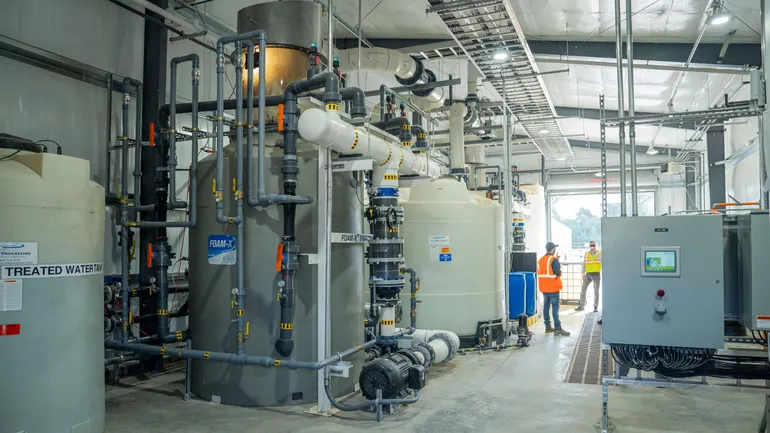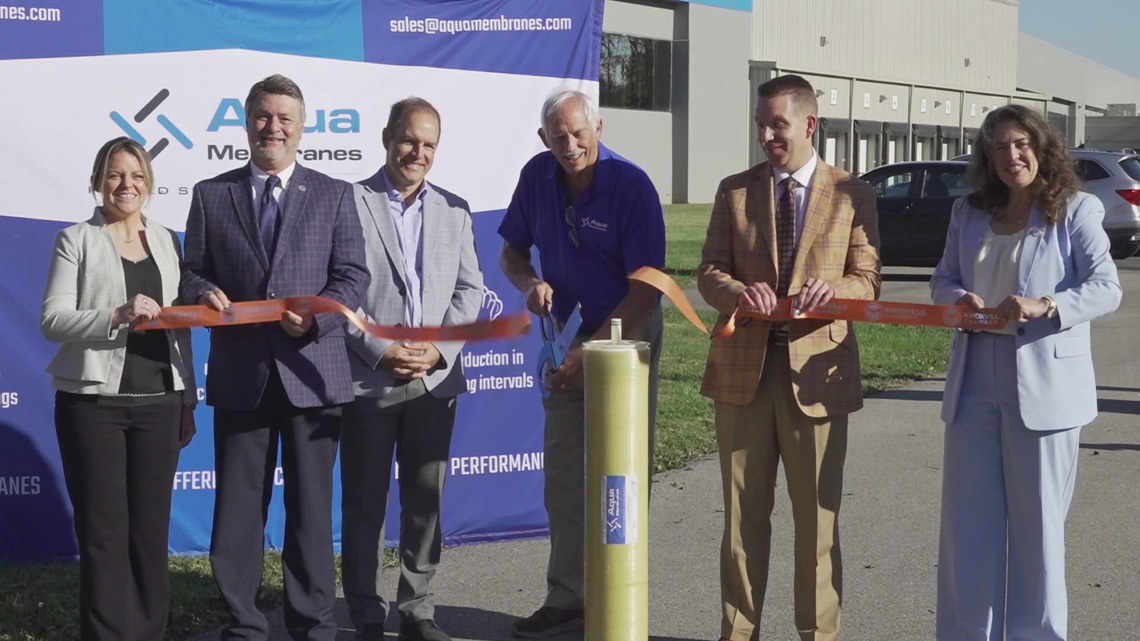Zwitterionic membrane technology: Revolutionising industrial water treatment and reuse – Smart Water Magazine

Report on Zwitterionic Membrane Technology and its Contribution to Sustainable Development Goals
Addressing Industrial Water Management in Support of SDG 6 and SDG 12
Advanced membrane technologies present a critical solution for improving industrial water treatment and reuse, directly supporting the achievement of Sustainable Development Goal 6 (Clean Water and Sanitation) and SDG 12 (Responsible Consumption and Production). ZwitterCo’s zwitterionic membranes offer reliable and efficient solutions for treating challenging wastewater, enabling industries to enhance their sustainability performance. By facilitating water recycling and safe discharge, this technology helps meet SDG Target 6.3, which aims to improve water quality by reducing pollution and substantially increasing safe reuse globally. It also aligns with SDG 12.2 and 12.5 by promoting the efficient use of natural resources and reducing waste generation.
Key industrial sectors benefiting from this technology include:
- Meat and poultry processing
- Dairy production
- Corn ethanol facilities
- Sugar refining plants
- Power generation stations
- Landfills and food waste digestate facilities
- Bioprocessing plants
- Oil and gas operations (produced water management)
- Farms (manure runoff treatment)
Technological Innovation for Sustainable Infrastructure (SDG 9)
The foundation of this technological advancement lies in zwitterionic chemistry, representing a significant innovation in filtration science that contributes to SDG 9 (Industry, Innovation, and Infrastructure). Conventional ultrafiltration (UF) membranes typically utilize polymers like polyvinylidene fluoride (PVDF) or polyethersulfone (PES). However, ZwitterCo’s technology is based on zwitterionic copolymers.
A zwitterion is a molecule that contains both positive and negative charges, rendering it electrically neutral and highly hydrophilic (water-loving). By engineering copolymers from zwitterionic monomers, researchers have developed membranes with exceptional anti-fouling properties. This innovation represents a step-change in performance, upgrading industrial capabilities in line with SDG Target 9.4, which calls for retrofitting industries to make them sustainable.
Performance Outcomes and Sustainability Impact
The operational performance of zwitterionic membranes delivers tangible benefits that align with multiple Sustainable Development Goals. The technology’s ability to maintain performance in streams containing high concentrations of fats, oils, greases, and dissolved organics is a critical breakthrough for industrial wastewater management.
- Consistent Throughput and Rejection: The membranes provide stable and reliable filtration, ensuring that treated water meets quality standards for reuse or discharge. This directly supports SDG 6.3 by increasing the proportion of safely treated wastewater.
- Reduced Cleaning Frequency: Superior anti-fouling properties mean the membranes require significantly less chemical cleaning. This contributes to SDG 12.4 by promoting the environmentally sound management of chemicals and reducing the operational footprint of treatment facilities.
- Extended Operational Life: The durability of the membranes leads to a longer lifespan compared to conventional alternatives, which aligns with SDG 12.5 by substantially reducing waste generation from frequent membrane replacements.
- Enhanced Water and Resource Security: By enabling effective treatment and reuse of industrial process water, the technology helps protect vital water sources from pollution, contributing to the health of aquatic ecosystems (SDG 14) and terrestrial environments (SDG 15).
1. Which SDGs are addressed or connected to the issues highlighted in the article?
The article on ZwitterCo’s membrane technology for wastewater treatment directly and indirectly addresses several Sustainable Development Goals (SDGs). The core focus on water purification and reuse connects it to goals concerning water, industry, sustainable communities, and responsible production.
-
SDG 6: Clean Water and Sanitation
This is the most directly relevant SDG. The article’s central theme is the development and application of an advanced membrane technology for treating “difficult wastewater problems” and enabling “water treatment and reuse across many industries.” This directly contributes to ensuring the availability and sustainable management of water and sanitation for all.
-
SDG 9: Industry, Innovation, and Infrastructure
The article highlights a “breakthrough in filtration science” and an innovative technology (“zwitterionic copolymers”) that makes industrial processes more sustainable. By providing solutions for industries like “meat and poultry processing, dairy production, corn ethanol facilities,” and “oil and gas operations,” the technology supports the goal of building resilient infrastructure and fostering sustainable industrialization.
-
SDG 11: Sustainable Cities and Communities
The technology’s application in treating wastewater from “landfills” and managing urban and industrial by-products helps in reducing the adverse environmental impact of cities. Effective management of industrial wastewater and landfill leachate is crucial for creating safer and more sustainable urban environments.
-
SDG 12: Responsible Consumption and Production
By enabling “water treatment and reuse,” the technology promotes the efficient use of natural resources (water). It helps industries reduce their water footprint and manage their waste streams, such as “food waste digestate” and “manure runoff,” in an environmentally sound manner, aligning with the principles of a circular economy and sustainable production patterns.
2. What specific targets under those SDGs can be identified based on the article’s content?
Based on the solutions described in the article, several specific SDG targets can be identified:
-
SDG Target 6.3: Improve water quality by 2030
The article directly addresses this target by describing a technology that offers “reliable and efficient solutions for water treatment.” It aims to improve water quality by treating wastewater from various sources, including “meat and poultry processing,” “dairy production,” and “landfills,” which are often laden with “fats, oils, greases, and dissolved organics.”
-
SDG Target 6.4: Substantially increase water-use efficiency
The mention of enabling “water treatment and reuse across many industries” directly links to increasing water-use efficiency. By allowing industries to treat and reuse their wastewater, the technology reduces the demand for fresh water, a key component of this target.
-
SDG Target 9.4: Upgrade infrastructure and retrofit industries to make them sustainable
The article describes ZwitterCo’s membranes as a “step change” technology that makes industrial filtration more efficient and sustainable. By adopting these membranes, industries can retrofit their water management systems to be more resource-efficient and environmentally sound, as they “dramatically extend operational life” and “require significantly less cleaning.”
-
SDG Target 11.6: Reduce the adverse per capita environmental impact of cities
The technology’s use in treating wastewater from “landfills” and managing industrial effluents from plants located in or near urban areas contributes to this target. Proper treatment of such waste streams is essential for reducing pollution and improving the urban environment.
-
SDG Target 12.2: Achieve the sustainable management and efficient use of natural resources
The core function of the technology—enabling water reuse—is a direct contribution to the efficient use of water, a critical natural resource. It allows industries to minimize their water consumption by creating a closed-loop system.
-
SDG Target 12.4: Environmentally sound management of chemicals and all wastes
The technology is used to manage various industrial waste streams, including “produced water” from oil and gas, “food waste digestate,” and “manure runoff.” Furthermore, the membranes’ “exceptional anti-fouling properties” mean they “require significantly less cleaning,” which implies a reduction in the use of cleaning chemicals, contributing to the environmentally sound management of chemicals.
3. Are there any indicators mentioned or implied in the article that can be used to measure progress towards the identified targets?
The article implies several performance metrics that can serve as indicators for measuring progress towards the identified targets:
-
Indicator for Target 6.3 (Improve water quality)
An implied indicator is the proportion of industrial wastewater safely treated. The article states the membranes maintain “consistent throughput and rejection rates even in streams laden with fats, oils, greases, and dissolved organics.” Measuring the reduction in these pollutants post-treatment would serve as a direct indicator of improved water quality (related to Indicator 6.3.1).
-
Indicator for Target 6.4 (Increase water-use efficiency)
The volume of water reused by industries adopting this technology is a clear indicator. The article’s focus on “water treatment and reuse” implies that a key metric for success is the amount of water recycled back into industrial processes, which directly measures change in water-use efficiency (related to Indicator 6.4.1).
-
Indicator for Target 9.4 (Sustainable industries)
The rate of adoption of this advanced, environmentally sound technology by the mentioned industries (“meat and poultry,” “dairy,” “corn ethanol,” etc.) is an indicator. Additionally, the “dramatically extend[ed] operational life” and reduced cleaning requirements are metrics for resource efficiency within the industry (related to Indicator 9.4.1 on resource efficiency).
-
Indicator for Target 12.4 (Sound waste management)
The volume and type of industrial waste streams treated (e.g., landfill leachate, produced water, food waste digestate) is a direct indicator. A secondary indicator is the reduction in cleaning chemicals used due to the membranes’ anti-fouling properties, which the article highlights by stating they “require significantly less cleaning.”
4. Create a table with three columns titled ‘SDGs, Targets and Indicators” to present the findings from analyzing the article. In this table, list the Sustainable Development Goals (SDGs), their corresponding targets, and the specific indicators identified in the article.
| SDGs | Targets | Indicators (Mentioned or Implied in the Article) |
|---|---|---|
| SDG 6: Clean Water and Sanitation | Target 6.3: Improve water quality by treating wastewater. | Proportion of industrial wastewater treated; Rejection rates of fats, oils, greases, and dissolved organics. |
| Target 6.4: Increase water-use efficiency and promote reuse. | Volume of water reused by industries implementing the technology. | |
| SDG 9: Industry, Innovation, and Infrastructure | Target 9.4: Upgrade infrastructure and retrofit industries to make them sustainable. | Rate of adoption of the advanced membrane technology by industries; Extended operational life of filtration systems. |
| SDG 11: Sustainable Cities and Communities | Target 11.6: Reduce the adverse environmental impact of cities. | Volume of landfill leachate and urban-based industrial wastewater treated. |
| SDG 12: Responsible Consumption and Production | Target 12.2: Achieve sustainable management and efficient use of natural resources. | Reduction in freshwater consumption by industries due to water reuse. |
| Target 12.4: Environmentally sound management of chemicals and all wastes. | Volume of waste streams treated (e.g., produced water, food waste digestate, manure runoff); Reduction in cleaning chemicals used due to anti-fouling properties. |
Source: smartwatermagazine.com

What is Your Reaction?
 Like
0
Like
0
 Dislike
0
Dislike
0
 Love
0
Love
0
 Funny
0
Funny
0
 Angry
0
Angry
0
 Sad
0
Sad
0
 Wow
0
Wow
0













































































